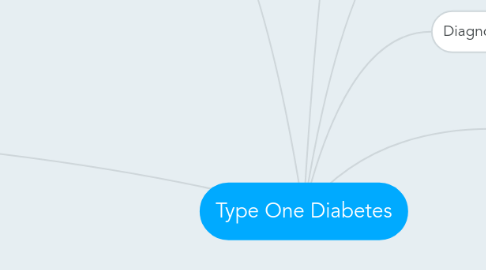
1. Treatment
1.1. Manual Insulin Injections
1.1.1. Since the body can no longer produces its own insulin, individuals have to manually inject insulin into their body to allow the glucose to enter the cells. These injections are given before/after meals or to correct abnormal numbers.
1.1.2. There are three different types of insulin: Rapid-Acting Insulin, Long-Acting Insulin, and Intermediate Insulin.
1.2. Manual Blood Sugar Monitoring
1.2.1. Individuals have to prick their fingers to see what their blood sugars are and to make sure they are in range. Check the blood sugar levels, helps diabetics keep their numbers in range and keeps them healthy.
2. Clinical Manifestations
2.1. Uncontrolled Type One Diabetes
2.1.1. Heart and blood Vessel Disease: diabetes increases risk for many cardiovascular problems- heart attack, stroke, narrowing of the arteries, high blood presssure
2.1.2. Neuropathy: high blood sugar injures the walls of capillaries that nourish the nerves, resulting in tingling, numbness, and burning. Eventually can lead to lose of sensation in limbs.
2.1.3. Eye Damage: the high blood sugar affects the blood vessels of the retina, potentially leading to blindness.
2.1.4. These manifestations usually result after years of uncontrolled diabetes, so these would affect the older population of type one diabetics.
2.2. If patient controls their diabetes they can live a long healthy life with little to no complications.
2.3. Hypoglycemia
2.3.1. Low blood sugar: to much insulin was giving so to much glucouse in the blood was taken inside the cell.
2.3.2. Signs and Symptoms of Hypoglycemia
2.3.2.1. shaky and jittery
2.3.2.2. sweaty and hungry
2.3.2.3. blurred vision
2.3.2.4. sleepy, tired, confused
2.3.2.5. Seizures or convulsions and Unconsciousness
2.3.3. Treated by eating/drinking carbohydrates
2.4. Hyperglycemia
2.4.1. Too much glucose is in the blood system due to the lack of insulin.
2.4.2. Signs and symptoms
2.4.2.1. Increased thirst
2.4.2.2. headaches
2.4.2.3. Trouble Concentrating
2.4.2.4. Blurred vision
2.4.2.5. Frequent peeing, Fatigue, weight loss
2.4.3. Treatment includes correcting sugar levels with insulin shots.
3. Pathogenesis
3.1. Autoimmune disease
3.2. Beta cells in the pancreas are turned off and no longer produce insulin.
3.2.1. Because there is no Insulin the glucose stays in the blood stream and the inviduals cells starve.
4. Those who are at Risk
4.1. Cause is still unknown
4.2. Genetic Factors and Environmental Triggers are believed to bring on onset
4.3. Most commonly is diagnosed in individuals ranging from 4-15, but can ultimately affect anyone at any age.
5. Some Statistics Behind T1D
5.1. 1.25 million Americans are living with T1D including about 200,000 youth (less than 20 years old) and over a million adults (20 years old and older
5.2. The global prevalence of diabetes among adults over 18 years of age has risen from 4.7% in 1980 to 8.5% in 2014
5.3. 40,000 people are diagnosed each year in the U.S
5.4. The countries who have the highest incidence of type one diabetes include, Finland, Sweden, Saudi Arabia, Norway, United Kingdom, USA.
6. Diagnostics
6.1. Non Diabetic Normal Readings
6.1.1. Blood Glucose Levels: <100mg/dl
6.1.1.1. A1C; <5.7%
6.2. Diabetic Target Readings
6.2.1. Blood Glucose Levels : 80-150 mg/dl
6.2.1.1. A1C target 7%: A1C "diabetic range" >6.5%
